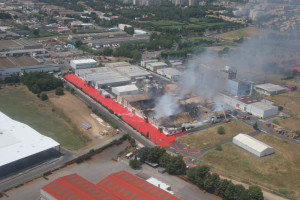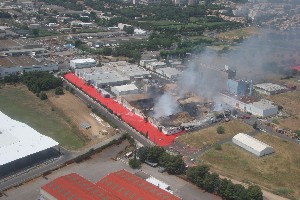A fire was reported at 3.05 am, during the night from Sunday to Monday, in one of 4 buildings (A/B/C/D) adjacent to a site producing agro-pharmaceutical products (powders, granulates) and storing finished solid and liquid products. The installations were shut down at the time of the accident. Less than an hour after conducting his round, the security guard sounded the alarm upon confirming that there was a fire in zone D1. The executive on duty and the director made their way to the plant. The firemen noted that 3 of the buildings were on fire upon their arrival at 3.27 am. The utilities were disconnected and the internal contingency plan was initiated, followed by the special intervention plan at 4.22 am. A confinement perimeter of 400 m was set up around the site. A flour silo and lightweight structures were sprayed with water to protect them. The firefighting water (500 m³/h) was recovered in a retaining basin at the lower portion of the site through the use of inflatable balloons. Following a malfunction of the lifting pump, part of the firefighting water was pumped and removed by trucks from a specialised company or transferred to a hermetic reservoir (10,000 m³) provided for this purpose after a mobile backup pump had been set up. Roughly one hundred firemen brought the fire under control by late morning; 5 had been injured or otherwise effected (burns, nausea) during the operation. The 4 buildings (7,500 m²) and a stock of 1,700 tons of phytosanitary products were destroyed. Property damage and operating losses were estimated at 40 M euros. A sharp odour was noticeable several dozen kilometres away, and 3,000 people were invited to stay at home or their place of work. The smoke caused discomfort among the residents and personnel of companies in the industrial estate. An analysis of the smoke revealed the presence of sulphur compounds (H2S, CS2, SO2) and HCN. Although the concentrations of CS2 exceeded the toxicity level (OEL 10 ppm) above the fire, none of the various pollutants exceeded the level at the site’s borders. Several companies within the industrial estate had to suspend their activities on the day of the accident. The firemen monitored the slow combustion of the chemical products with the release of fumaroles for several days. A mobile measuring station located 200 m downwind from the site monitored the concentration of sulphur products in the air. As the cause of the fire was unknown, a judicial inquiry was conducted and the insurance company appointed a claims expert. The Prefectoral Order of June 29th suspended operations at the site and required that all safety equipment be overhauled prior to the restart of all equipment not damaged in the fire.
Download the detailed report in .pdf format (521 Kb)





